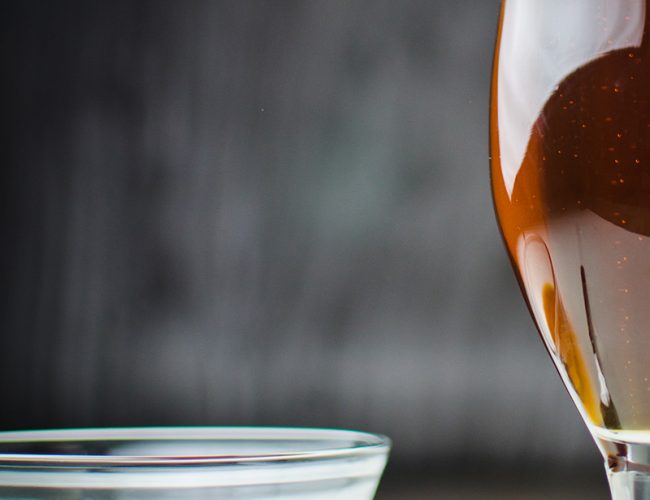The kitchen—a place of respite for some folks, stress for others, and likely the most popular room in the home to reconnect, talk, sip and nosh. Recipes are made, dishes are everywhere, a pot’s on the stove and people are gathered. If you can imagine this scene and it makes you smile, then perhaps you already like to cook with craft beer. And if you haven’t considered beer in your cooking yet, sauces are great place to start.
A sauce is definedOpens in new window as “a thick liquid that is eaten with or on food to add flavor to it.” Sauces thick and thin have much to add to our gustatory adventures. Using beer as a sauce ingredient amps up the opportunities and may actually help prevent the formation of worrisome chemicals formed in smoked and grilled fatty meats, as reportedOpens in new window by Discovery.com.
In addition to being readily available, beer offers nutritional attributes and a myriad of flavor contributions that are as intense as the beer you choose, and as diverse as the cooking methods you apply. Here are three important things to consider when using craft beer in sauces.
1. Can you universally exchange beer for other liquids ounce for ounce?
When cooking, the answer to the liquid-for-liquid question is: “Yes and no.” Can you trade out? Yes, but you have to be thoughtful about which liquids you’re trading.
For instance, if you want to swap milk for beer, you’ll need to consider why the milk is there in the first place. Milk has protein, whey and fat (sometimes). Beer has no fat, a lot of water and the protein content is low. You could substitute some beer for milk, but a whole trade wouldn’t be wise.
It’s also important to consider what type of recipe the trade is being applied to. Baking is going to lessen the margin for error much more than something like a marinade, where there’s a lot more room to use beer.
You can use beer in cold sauces including salsas, cocktail dips and marinades (aka “beerinades”) right out of the tap.
When prepping fresh vegetable salsa, add a splash of crisp, grapefruity IPA for a spark of flavor. When grilling red meat, an amber ale marinade will not only help tenderize the meat, it will provide mild acidity and add subtle flavors to really make the meat sing.
2. Is a reduction always necessary when cooking with beer?
A reduction is needed when you want a sauce to cook down and concentrate the flavors by cooking off (evaporating) some of the liquid. For example, a sweet sauce to top ice cream may be best when reduced to a thicker viscosity. A thin sauce to drizzle on fish may need very little, if any, reduction. The best thing to do is experiment.
An important variable to consider when making a reduction with beer is what you’d like the final viscosity (thickness) to be. If you’ll be coating food with the sauce, you may want to reduce more–or use a smaller amount of beer to begin with—as the added liquid is liable to dilute your sauce. If it’s a glaze—a much thinner sauce—less or no reduction is needed.
Less can be more, so start adding or substituting beer slowly and ramp up your experiments as you become more knowledgeable and comfortable. Try making sauces you’re interested in a few times, really paying attention while playing around. Keep a notepad close by to record your thoughts as you become more adept and successful.
3. Can chocolate beers only be successfully used in sweet sauces?
Whoever first used a beer with chocolate characteristics in cooking deserves a gold medal. For many beer enthusiasts it’s a foregone conclusion that a chocolatey beer goes well with and in foods. So should we only use chocolatey beers in sweet sauces? Absolutely not.
Chocolate flavors in beers can come from actual chocolate (cocoa and/or nibs) or various malts used in the brewing process. In cooking, beers that have a chocolatey flavor profile are much more flexible than some may think. Learn more: “Beer and Chocolate’s Not-So-Secret Love Affair.”
Try this on for size: Use a chocolate beer in your chili. It will add depth and complexity to your favorite recipe. Marinate hearty red meats in a chocolate beer for an extra layer of flavor. Use an imperial porter in brownies, either in the batter or for frosting (or both!). It’s a sweet proposition to use chocolate beers in your cooking.
Sauce It Up
A fun facet of cooking with craft beer is that there is huge potential gain for very little pain. If you use water in a soup, use beer instead. If you use vinegar in a dressing, replace it with beer. If you rehydrate beans with water, try beer instead. When you’re baking, think about replacing some of the liquids with beer. Do keep in mind that depending on the cooking method, some alcohol can remain in the finished dish.
So go ahead, pick up a few of your favorite craft beers and get in the kitchen. You’ll reward yourself and your friends with flavorful food and fun!
Delicious Dark Beerinade
For every 1 – 2 pounds of red meat, salmon or tofu:
3/4 cup Left Hand Milk Stout 1/4 cup olive oil 1 heaping Tbsp dry cocoa 1 heaping tsp finely diced Anaheim or Pablano pepper Fresh ground cracked pepper to taste Pinch of salt Combine the beerinade, pour over protein in a glass or stainless steel pan. Turn every 20 minutes until ready to cook (at least 40 minutes). Grilling imparts an extra luscious caramelizing.
CraftBeer.com is fully dedicated to small and independent U.S. breweries. We are published by the Brewers Association, the not-for-profit trade group dedicated to promoting and protecting America’s small and independent craft brewers. Stories and opinions shared on CraftBeer.com do not imply endorsement by or positions taken by the Brewers Association or its members.


Share Post